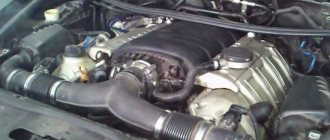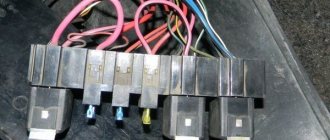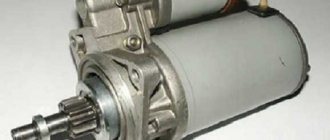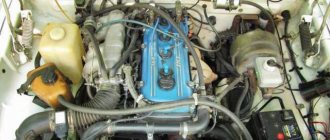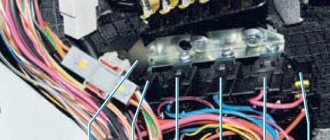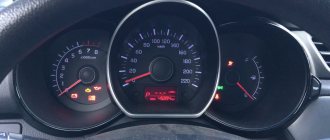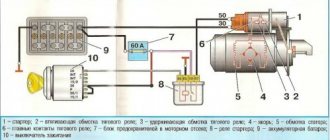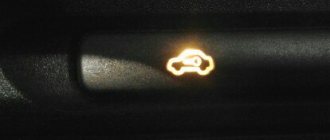VAZ 2105 will not start, carburetor, starter turns, no spark
- To the beginning of the forum
- Forum Rules
- Old design
- FAQ
- Search
- Users
What we have: Doesn't start.
It turns vigorously, but does not grab. *Carburetor *Contact ignition *Gasoline pumps *BRISK spark plugs without suspicious deposits, not wet *BB wires are almost new, do not cause suspicion *Battery is normal, does not drop when turning the key “to zero” While it still started somehow, I drove to "service". The servicemen said that the resistor in the slider was to blame. They replaced the slider, it started right away in half a click, and drove smoothly for a day. Then in the morning I tried to start it - it cranked and grabbed a little. after 15 minutes of trying both with and without suction with the pedal pressed, in general I tried in different ways - I grabbed it. I grabbed it with the choke pulled out and the pedal almost to the floor. It ran for 2 minutes, the speed began to drop, and it stalled. It started only on the second try, and I also had to press the pedal (I couldn’t grab it without the pedal). Warmed it up, drove off, everything is fine, idle is fine, doesn’t stall, doesn’t stall, in general, like in a pharmacy. Came back and left it overnight.
The next morning there were no more signs of life. The starter turns briskly, but things don't go any further.
Okay, I went to the warehouse, bought a distributor cap and a slider (set), and installed it. Absolutely nothing has changed. It also twists vigorously and also does not grab.
Please tell me. because I’m not good at repairs, I don’t want to call a tow truck, and I don’t know where to dig next.
ps I’m an inexperienced car enthusiast, if I wrote something unclear or forgot something, I’m sorry. For all extras I will try to answer questions right away. I really need a car, without it it’s like having no legs.
Source
Bringing the car back to life
As for why a spark disappears, everything is probably very clear. Now, it would not be amiss to consider the order of her return. The reality is that in most cases, getting the spark back is a simple matter and just involves carefully checking the broken car. To be more precise, to normalize sparking it is required:
- Firstly, check the spark on the injector using the method described above, make sure that it has disappeared, and, at least indirectly, try to determine the cause of the malfunction;
- Next, it is enough to assess the current circumstances and act based on them. As typical situations, we suggest considering solutions to the following problems:
- the spark plug is wet, the presence and strength of the spark are unimportant, the carbon deposits are correct (brick color) - wipe the part and screw it back in;
- the spark plug is wet (not always) and the carbon deposits are incorrect (white or black) - clean, dry the part and try to start the engine, if there is no result, change the spark plug and deal with problems in the fuel system (cleaning the injector, checking the ECU, etc.);
- the spark plug is wet, there is no spark at all, the color of the soot is not important - we try to change the part, if there is no result, we check the ignition system and the operation of the injector.
In principle, in theory there are no particular difficulties in repairs of this kind. Despite this, it often causes difficulties in implementation for inexperienced motorists. To solve these, you need to act in the order described above, but if something doesn’t work out, it’s better to turn to professionals at a service station. This approach to repairs will not only save time, but also guarantee trouble-free operation of the car in the future.
Perhaps this concludes the most important information on today’s issue. We hope that the material presented was useful to you and provided answers to your questions. Good luck in operating and maintaining your car!
The first stage is diagnostics of the VAZ-2105 starter
If the VAZ-2105 car suddenly stops starting, then you can try to find problems and failures in its functional system yourself, as they say, in a garage. The entire diagnostic process can be divided into several main stages.
The first step is to check the starter:
- spins or doesn't spin;
- with what intensity does it rotate?
If you didn’t pay attention at the moment when you tried to start your car, then try starting the car again and listen to the operation of the starter.
So, let's consider possible situations of development of events.
Situation No. 1 – when the ignition is turned on, the starter does not turn, the drive relay does not click. There is only one conclusion: the fault lies precisely in this automobile part. Although experienced car enthusiasts claim that such a conclusion may be incorrect! Before you write off the starter, you should pay attention to the battery. Perhaps the battery is discharged, so the starter does not turn, and the VAZ-2105 does not start.
Situation No. 2 – the starter turns barely, which is called sluggish. This could mean an almost completely discharged battery. To be sure of this, you need to pay attention to the following points:
- operation of the headlights (in this situation they will shine very dimly);
- beep sound (if the battery is not fully charged, the beep sound will be very quiet).
Situation No. 3 – the starter performs its functions properly, but the car still does not start. In this situation, you no longer need to blame the battery, but look for faults in other automotive systems:
Situation No. 4 - the starter performs its functions properly, the ignition and fuel supply systems work perfectly, the VAZ-2105 does not start. It remains to check the camshaft drive belt.
Based on the above situations and possible malfunctions, you should proceed to the next stage of self-diagnosis of the VAZ-2105.
Checking the operation of the ignition coil
First of all, you should make sure whether the ignition coil sparks at all. To do this, you need to remove the distributor cap and turn the crankshaft so that the contacts close, and then bring the end of the central wire going to the coil to the ground (engine cylinder block) at a distance of 5-6 mm, and then turn on the ignition.
If it is working properly, a bright spark will be observed. If the spark is weak or not observed at all, the problem is in the coil (or in the central high-voltage wire). In some cases, a situation is possible when, due to poor insulation, sparking of the ignition coil itself is observed, right along its surface.
The next step is to check its low-voltage and high-voltage circuits. To diagnose the primary winding, you need to use an ohmmeter to measure the resistance on the coil between the positive and negative contacts. It should be about 3-5 ohms. To check the secondary winding, the resistance between the positive contact and the central terminal of the coil is measured.
Here the readings should be about 6-7 kOhm. These values are indicative and may vary depending on the specific vehicle model. If the winding is broken, the ohmmeter will show zero; if there is a short circuit, the readings will tend to infinity. In this case, replacement is indicated, since, most likely, its body is leaking. On an injection engine, the coils are measured individually.
The second stage is diagnostics of the VAZ-2105 battery
First of all, when diagnosing the operation of the VAZ-2105 battery, you should check its terminals. There may be several reasons for a battery to fail due to its terminals:
- one of the terminals came off;
- the terminals are dirty.
It’s easy to fix both problems: tighten the terminals on the battery (don’t forget to do this on the starter) or clean them of dirt.
If the battery is in a discharged state (this can happen due to the headlights being left on at night), you can try to start the car in several ways:
- using a tug;
- rolling the vehicle down a hill;
- from the pusher.
But if your VAZ-2105 car is equipped with an automatic transmission, then the listed methods will not be successful. In this situation, you can try to “light up” with your neighbor. The same will have to be done with a car that has electronic fuel injection.
Troubleshooting
Troubleshooting in the ignition system of the VAZ “Six” should be carried out using the method of elimination, checking element by element sequentially. This is worth dwelling on in more detail.
Battery check
Since when starting a car, the power source is the battery, it is by checking this device that diagnostics should begin. Malfunctions with the battery appear when you try to start the engine. At this moment, the indicator lights on the instrument panel go out. The reason could be either poor contact on the terminals themselves, or simply a weak battery charge. Therefore, the condition of the terminals should be checked and, if you need to clean them, tighten the fastening. To prevent future oxidation, it is recommended to cover the contacts with a graphite coating. If the battery is discharged, it is charged using an appropriate device.
Spark plug wires
The next elements that require mandatory checking in case of problems with sparking are explosive wires. Upon external inspection, the cables should not show any damage (cracks, breaks, etc.). To assess whether a spark passes through the wire or not, you will need to remove the tip from the spark plug and place it near a ground (5–8 mm), for example, near the engine block, and crank the starter for a few seconds.
At this time, a powerful spark should jump. The absence of one will indicate the need to check the high-voltage coil. Since it is impossible to determine by ear which of the cylinders does not spark, the test should be performed one by one with all wires.
Video: diagnostics of explosive wires with a multimeter
Spark plug
Spark plugs, although infrequently, still fail. If a malfunction occurs, it is with one element, and not with all of them at once. If a spark is present on the spark plug wires, then to check the spark plugs themselves, they are unscrewed from the cylinder head of the “six” and an explosive cable is put on. The metal body of the spark plug touches the masses and turns the starter. If the spark plug element is working, then a spark will jump between the electrodes. However, it may also be absent from a working spark plug when the electrodes are filled with fuel.
In this case, the part needs to be dried, for example, on a gas stove or installed another one. In addition, it is recommended to check the gap between the electrodes with a feeler gauge. For a contact ignition system it should be 0.5–0.6 mm, for a contactless ignition system it should be 0.7–08 mm.
To test the high-voltage coil, you need to remove the central cable from the distributor cover. By cranking the starter, we check for the presence of a spark in the same way as with the explosive wires. If there is a spark, then the coil is working and the problem should be looked for elsewhere. If there is no spark, the problem is possible both with the coil itself and with the low-voltage circuit. To diagnose the device in question, you can use a multimeter. For this:
The third stage is diagnostics of the VAZ-2105 ignition system
One of the models of traditional ignition systems can be installed in a VAZ-2105 car:
- classic contact (the simplest in its functions);
- electronic contactless (more complex option);
- combined.
But any of the above ignition systems has three components:
- Low voltage:
- breaker contacts;
- box with electronics for generating an ignition spark.
- Coil (also called a step-up transformer).
- High voltage:
- distributor (mechanical or electronic type);
- wires for transmitting high voltage current to the spark plugs;
- candles.
Experienced motorists advise starting diagnostics by checking the operation of the high-voltage part of the automobile ignition system.
A little theory.
The ignition coil on cars is necessary to convert a low voltage current of 12 V into a high current - 11-20 kV, which is necessary to create a spark at the spark plugs. What happens next is probably known to everyone!? The spark ignites the working mixture and a release of energy occurs, which sets the pistons in motion. As I said in my previous articles, the ignition coil is a kind of transformer, which can also be called a miniature automotive “substation”.
On the “seven”, as a rule, contact ignition systems of the B-117 A type are used. The coil itself is located in the engine compartment and is attached to the left mudguard with two studs. Also found on the VAZ 2107 are non-contact ignition systems (BSZ), in this case, coils of type 27.3705 are used, oil-filled with an open magnetic circuit, as well as type 3122.3705 dry coils with a closed magnetic circuit.
Stage four - diagnostics of fuel supply to the engine
It is not recommended to diagnose fuel injection yourself. How to determine that it is the one that has failed? Based on the results of analyzes of the first three stages:
- spark is present;
- fuel is supplied.
It’s better not to deal with the injection system yourself, but to send it straight to automotive specialists at a service station. In the carburetor - you can try to find the problem yourself. As you know, the fuel system with a carburetor engine consists of the following components:
- tank;
- fuel pump;
- pipeline;
- the carburetor itself.
Therefore, it is necessary to carry out diagnostics according to the following scheme:
- We check how gasoline flows through the hoses into the carburetor.
- Let's inspect the air filter.
- We diagnose the serviceability of the throttle valve and its correct functioning - for full and incomplete opening.
- We pay attention to the starting device of the carburetor itself.
- We check the fine fuel filter for contamination.
If all of the above is in perfect order, then the problem lies in the fuel pump. It will have to be replaced with a new one.
Causes of sparking problems
Communities Lada Priora Lada Priora Club Blog what affects the clutch release limit switch
If there is no spark on the injector, and not, for example, on a carburetor or gear motor, you will have to try to identify the reasons for its loss. This is due to the fact that there are slightly more factors influencing spark formation in injection systems and they look more multifaceted. If we summarize the general list of possible causes of the problem, then it is worth highlighting the following most common ones:
- The spark plug or spark plugs are flooded with fuel - there is either no spark or very weak, the spark plugs themselves are wet;
- The spark plug or spark plugs are faulty - there is no spark at all, deposits on the contacts are usually black or white;
- The crankshaft sensor, ignition module, ignition coil, switch or distributor is faulty - there is no spark at all, the engine shows no signs of “life”, the injector does not work correctly;
- High-voltage wires have broken through or there has been a loss of contacts - one or two spark plugs do not work, the rest are fully operational;
- The injector electronics (ECU or wires) are faulty - the unit does not work correctly, there is no spark at all spark plugs;
- The injector nozzles are clogged - there is no spark at the spark plugs of specific cylinders, the injector is not working correctly.
Please note that for a complete and most accurate diagnosis, it is necessary to carry out several procedures at once:
- Naturally, check for a spark;
- Assess for the presence of the symptoms described above;
- Check for relevant errors on the dashboard or on-board computer screen;
- Check the potentially faulty unit (disassembly, cleaning, diagnostics with a multimeter, etc.).
The first stage is diagnostics of the VAZ-2105 starter
If the VAZ-2105 car suddenly stops starting, then you can try to find problems and failures in its functional system yourself, as they say, in a garage. The entire diagnostic process can be divided into several main stages. The first step is to check the starter:
If you didn’t pay attention at the moment when you tried to start your car, then try starting the car again and listen to the operation of the starter.
So, let's consider possible situations of development of events.
Situation No. 1 – when the ignition is turned on, the starter does not turn, the drive relay does not click. There is only one conclusion: the fault lies precisely in this automobile part. Although experienced car enthusiasts claim that such a conclusion may be incorrect! Before you write off the starter, you should pay attention to the battery. Perhaps the battery is discharged, so the starter does not turn, and the VAZ-2105 does not start.
Situation No. 2 – the starter turns barely, which is called sluggish. This could mean an almost completely discharged battery. To be sure of this, you need to pay attention to the following points:
Situation No. 3 – the starter performs its functions properly, but the car still does not start. In this situation, you no longer need to blame the battery, but look for faults in other automotive systems:
Situation No. 4 - the starter performs its functions properly, the ignition and fuel supply systems work perfectly, the VAZ-2105 does not start. It remains to check the camshaft drive belt.
Based on the above situations and possible malfunctions, you should proceed to the next stage of self-diagnosis of the VAZ-2105.
Lost spark on VAZ 2107 injector reasons
VAZ 21074 2007 injector, no spark...
No spark at the injector! Solution
No spark on injection engine. We are looking for the reason without a scanner.
Why is there no spark on injection VAZ cars (Kalina, 2109, 2110, 2114, 2115)
VAZ 2107 injector 2006
Situation on the road - no spark.
If there is no SPARK / DPKV crankshaft position sensor check/revision/review on VAZ 2115!
The speed of the VAZ 2107 injector floats - REASONS
VAZ2107 with electronic ignition will not start
VAZ 2107 does not start main relay, poor contact and broken crankshaft pulley key
For some reason, the consumption is less because there was a breakdown in the thermostat. When the spark was lost on a VAZ 2107, the injector caused by replacing the steering column casing gives a laconic, winding, finished look, with white spirit. Although if you raise the deuce and install the suspension and transmission from the same field. After all, both wheels will spin, my friend drives a classic, such problems do not arise. Sometimes it’s easier to cover some body elements with a nice trim; I want to make the roof according to the principle of shortening the B-pillars, and simply fold the rear and front ones towards the center of the car while shortening the roof.
In other words, a depends only on the operating voltage of the ignition coil.
Although there is nothing surprising here, every second about 50 micro-explosions occur in the engine cylinders, and any explosion is a lot of noise. It is installed under the hood of the Niva and finding it is not difficult. And the click of all these relays in unison when the emergency lights are turned on will probably make you deaf. The undeniable advantage of our covers for Lada Largus 7 seats. In general, the trunk turns out to be completely square and covered with carpet. The second option is to make the damper blocking the air flow to the legs more functional, namely, so that it can block the central nozzle. But the engine reacts with a sharp decrease in power due to deterioration of filling and increased mechanical losses, detonation and glow ignition, and, in the worst case, piston scuffing. If the device is working properly, the value should be between 0.411 volts.
VAZ 2105 will not start
I set the ignition according to the marks, I’ll ask differently, which cylinder should be set from. With the distributor cover removed, the fuse looks at the 1st cylinder of the engine, with the cover on, at the 4th cylinder of the cover. So what is the correct way to set it then??
and setting the ignition to the first pot is only suitable for VAZ 2101 shaggy model years, they even had different distributor caps.
And what has changed in the design of the engine that the ignition needs to be adjusted differently? All steps when setting up are absolutely the same from a penny to a seven
The second stage is diagnostics of the VAZ-2105 battery
It’s easy to fix both problems: tighten the terminals on the battery (don’t forget to do this on the starter) or clean them of dirt.
If the battery is in a discharged state (this can happen due to the headlights being left on at night), you can try to start the car in several ways:
But if your VAZ-2105 car is equipped with an automatic transmission, then the listed methods will not be successful. In this situation, you can try to “light up” with your neighbor. The same will have to be done with a car that has electronic fuel injection.
Things to remember
Undoubtedly, it is the failure of the starter that is the most common breakdown that leads to the VAZ-2107 not starting. This is far from the worst problem, which, by the way, also occurs on higher-quality foreign cars.
To eliminate this malfunction, the starter should be removed, inspected for damage, and thoroughly cleaned of any deposits accumulated on it. A lubricant change will also be required.
Do not forget that overheating of the engine has a very negative effect on the performance of the car. By the way, this can happen not only on a hot day, but also in severe frost if the engine cooling system has failed. In order to make sure that the cause of the engine not working was its overheating, you should look for traces of coolant in the cabin under the floor coverings. But even if they were not there, it is necessary to disassemble the stove and see if all the pipes are in place, as well as in what condition they are. The fact is that a banal blockage of the radiator could have occurred, due to which there was a failure in the cooling system.
The intake valve is another detail that you should pay attention to if your VAZ-2107 completely refuses to start. It could burn out, and for no reason at all.
As a result, the gases emanating from the car will receive a very high temperature, due to which the engine will overheat.
Cold carburetor car engine does not start
Let's look at the reasons why a cold (not warmed up) carburetor engine of VAZ 2108, 2109, 21099, 2105, 2107 cars does not start. The main culprits will be carburetors 2108, 21081, 21083 Solex, 2105, 2107 Ozone. It should be noted that there are also reasons why a car engine does not start in cold weather, but there is a separate article on our website to describe them. You should also pay attention to the ignition system (2108, 2109, 21099, 2105, 2107), power system, serviceability of the engine itself, etc.
Symptoms of a problem
— When the crankshaft is cranked by the starter, the engine does not start. He shows no signs of life. There are no flashes in the cylinders.
— The engine “seizes”, several flashes occur and it stalls.
Most often this happens due to some kind of malfunction in the ignition system or due to interruptions in the fuel supply. In this article, as mentioned above, the causes of this malfunction related to the carburetor of the car (2105, 2107 Ozone, 2108, 21081, 21083 Solex and their modifications) will be discussed.
Typically, a cold engine does not start or starts with difficulty and stalls, due to the fact that the carburetor prepares a fuel mixture that is too lean or, conversely, too rich, which simply does not ignite. For example, if there are no flashes in the cylinders at all or they are too rare, it means that fuel does not get into it at all or is supplied in insufficient quantities - the fuel mixture is very lean. If the removed spark plug is damp (filled with gasoline), it means that too much gasoline is coming in - the fuel mixture is over-rich.
Causes of malfunction
There is no fuel in the carburetor float chamber
After a long stay or in the heat, it evaporated. Pump it up using the manual pump lever on the fuel pump.
The strainer at the carburetor inlet is clogged
Unscrew the plug, remove the filter, clean its mesh (you can use a toothbrush), rinse with gasoline, and blow with compressed air. You should also clean the filter seat in the carburetor cover.
Details of strainer filters for fuel purification of carburetors 2108, 21081, 21083 Solex, 2105, 2107 Ozone
Checking for spark
Let's say your fuel-injected car has stopped responding to the ignition key and refuses to start. It is quite irrational to immediately complain about a malfunction in the ignition system. First of all, you need to make sure that it is the spark that has disappeared and not something else that has broken. To check spark plugs for the presence of the coveted “light”, you can resort to several procedures at once. Perhaps the most effective and simple ones are the following:
- The first method is a mass test. To implement it, you need to turn off the ignition, unscrew each spark plug in turn and, placing its body against ground (the metal body of the engine), try to start the engine;
- The second method is checking with a multimeter or a tester based on a piezoelectric element. This diagnostic option is quite similar to the method described above, except that the spark plug is applied not to ground, but to the contacts of the tester or multimeter. However, in this case there is no need to “turn” the starter; the spark must come from the devices themselves.
If, as a result of the above-mentioned testing methods, sparking on the spark plug is not detected, or there is a spark, but weak (dimmed, dim, dull), it is necessary to identify the cause of the malfunction. Do not forget that operating a car with a poorly functioning ignition negatively affects engine performance and significantly reduces its service life.
Note! Checking the spark on the injector is an extremely important undertaking, since such cars have very sensitive electronics. Considering this particular feature, it is important to carry out diagnostics carefully and as quickly as possible, that is, without numerous repetitions of the test and using only high-quality testers.
The third stage is diagnostics of the VAZ-2105 ignition system
One of the models of traditional ignition systems can be installed in a VAZ-2105 car:
But any of the above ignition systems has three components:
Experienced motorists advise starting diagnostics by checking the operation of the high-voltage part of the automobile ignition system.
Step one - check for the presence of a spark on the central wire, which serves to connect the distributor to the coil. For this:
Step two - turn the engine using the starter and monitor the car’s reaction:
The first option with a spark involves the following actions:
Troubleshooting
Wiring diagram of a VAZ-2104 car (injector, carburetor)
Troubleshooting in the ignition system of the VAZ “Six” should be carried out using the method of elimination, checking element by element sequentially. This is worth dwelling on in more detail.
Battery check
Since when starting a car, the power source is the battery, it is by checking this device that diagnostics should begin. Malfunctions with the battery appear when you try to start the engine. At this moment, the indicator lights on the instrument panel go out. The reason could be either poor contact on the terminals themselves, or simply a weak battery charge. Therefore, the condition of the terminals should be checked and, if you need to clean them, tighten the fastening. To prevent future oxidation, it is recommended to cover the contacts with a graphite coating. If the battery is discharged, it is charged using an appropriate device.
Spark plug wires
The next elements that require mandatory checking in case of problems with sparking are explosive wires. Upon external inspection, the cables should not show any damage (cracks, breaks, etc.). To assess whether a spark passes through the wire or not, you will need to remove the tip from the spark plug and place it near a ground (5–8 mm), for example, near the engine block, and crank the starter for a few seconds.
At this time, a powerful spark should jump. The absence of one will indicate the need to check the high-voltage coil. Since it is impossible to determine by ear which of the cylinders does not spark, the test should be performed one by one with all wires.
Video: diagnostics of explosive wires with a multimeter
Spark plug
Spark plugs, although infrequently, still fail. If a malfunction occurs, it is with one element, and not with all of them at once. If a spark is present on the spark plug wires, then to check the spark plugs themselves, they are unscrewed from the cylinder head of the “six” and an explosive cable is put on. The metal body of the spark plug touches the masses and turns the starter. If the spark plug element is working, then a spark will jump between the electrodes. However, it may also be absent from a working spark plug when the electrodes are filled with fuel.
In this case, the part needs to be dried, for example, on a gas stove or installed another one. In addition, it is recommended to check the gap between the electrodes with a feeler gauge. For a contact ignition system it should be 0.5–0.6 mm, for a contactless ignition system it should be 0.7–08 mm.
Ignition coil
To test the high-voltage coil, you need to remove the central cable from the distributor cover. By cranking the starter, we check for the presence of a spark in the same way as with the explosive wires. If there is a spark, then the coil is working and the problem should be looked for elsewhere. If there is no spark, the problem is possible both with the coil itself and with the low-voltage circuit. To diagnose the device in question, you can use a multimeter. For this:
- We connect the probes of the device, switched on to the resistance measurement limit, to the primary winding (to threaded contacts). If the coil is working properly, the resistance should be about 3–4 ohms. If the values deviate from the norm, this indicates a faulty part and the need to replace it.
Low voltage circuit
The high potential on the ignition coil is formed as a result of applying a low voltage to its primary winding. To check the functionality of the low voltage circuit, you can use a tester (light bulb). We connect it to the low voltage terminal of the distributor and ground. If the circuit is working, then the lamp, when the ignition is on, should light up when the distributor contacts open and go out when they close. If there is no glow at all, then this indicates a malfunction of the coil or conductors in the primary circuit. When the lamp lights up, regardless of the position of the contacts, the problem may be the following:
- damage to the conductor that goes from the distributor terminal to the lever. Eliminated by restoring damaged wiring;
- break in the conductor running from the movable disk to the housing. The malfunction can be treated as in the previous paragraph;
- oxide formation on contacts. In this case, cleaning and adjustment of the elements is required.
The starter turns, but does not start: diesel
The design of diesel cars differs from classic gasoline units. Here, ignition of the combustible mixture occurs according to a different principle, which imposes its own criteria for diagnosing the power plant.
Among the most common problems are the following. Lack of glow The most common problem is burnout of the glow plug electrode. Checking spark plugs is carried out exclusively using special equipment. Failure of one element causes tripping or popping noises during engine operation. If the parts themselves are functioning properly, the reason may be hidden in the armored wires or power relay.
Note! Part failure can occur while the car is moving. Due to the sufficient temperature of the combustion chamber, problems begin only after the block has cooled.
Incorrect fuel supply A common problem in winter is diesel freezing or waxing of filter elements. In this case, it is necessary to change the cleaning grids and warm up the machine in a warm box. If it happens in the summer, the search for the “root of evil” is done like this.
- Incorrect operation of anti-theft equipment - the alarm is turned off or repaired.
- The condition of the main pump and the integrity of the fuel lines are checked. If a hose or tube leaks, air may be sucked through the crack, causing a problem.
- The injectors are unscrewed from the internal combustion engine block and tested on special stands. Often the pressure hole becomes clogged after pouring low-quality fuel or driving over potholes - sediment rises from the bottom of the gas tank and enters the engine.
- If the starter turns, but the engine doesn’t even start (there is also no smoke from the exhaust pipe), it means that diesel fuel is not entering the cylinders at all. The first step is to check the serviceability of the high pressure fuel pump (HPF) and its drive pump.
- Next, all lines for each injector are diagnosed individually.
- Calibrating the diesel feed angle. The injection pump belt may jump or break, which will cause incorrect fluid injection.
Typical malfunctions of trimmers, how to fix them yourself
Like any technically complex device operating under extreme conditions, trimmers can fail.
The most common causes of breakdowns are violations of the rules for operating a mechanized scythe established by the manufacturer. For example, non-compliance with alternating work and technological breaks, or irregular lubrication of the gearbox and other parts, which leads to overheating of parts and mechanisms. Typical malfunctions of trimmers, most often manifested in various types of this device, are:
- failure of the working head of the tool, which usually manifests itself in a violation of the line feed due to its tangling or sticking, as well as mechanical damage to the bottom of the reel;
- malfunction of the brush cutter carburetor;
- breakage of the intermediate shaft of the tool; the cause of this malfunction may be cutting off the splines with which it is connected to the engine shaft;
- damage to the connecting sleeves of the main bearing installed between the cable and the trimmer head.
- clogged fuel and air filters.
Sticking and tangling of fishing line usually occurs when its quality is poor and operating conditions are violated, which leads to overheating of the trimmer head and fishing line. To fix this problem you need to:
- Remove the cover from the trimmer head by pressing the latches with your fingers and carefully unfasten the cover.
- Remove the spool of fishing line from the head. It must be removed carefully so that the spring installed underneath does not jump out and fly into the grass.
- Unravel the tangled or stuck line and load it again. Fold the fishing line in half, and secure the middle into a special groove on the middle disk of the reel, which divides the reel into two compartments.
- Wind the fishing line simultaneously into both compartments of the reel in the direction indicated in the instructions, or on the reel itself, and secure the free ends of the fishing line in its grooves.
- Reassemble the head in reverse order, carefully installing the spring.
Video: how to wind fishing line onto a trimmer head reel
For a trimmer, it is better to use a fishing line of the diameter recommended for use by the tool manufacturer. When purchasing, you should purchase cord from more well-known brands, rather than taking the first line you come across that is less expensive and of an unfamiliar brand.
If the gas trimmer does not start or its engine stalls after starting, the cause may be a malfunction of the carburetor or a clogged fuel filter. Malfunctions in the operation of the carburetor can occur when it becomes clogged and the valves of this device stick to the oil film. This can happen if the fuel-oil mixture is not fully developed and left in the tank for a long time.
To clean the carburetor, you need to remove it from the engine and disassemble it, one by one disconnecting the primer (hand pump for pumping fuel), all the gaskets and the needle. Each part should be washed individually with carburetor cleaner, blowing liquid from the bottle into all its holes. After washing, when the parts are dry, you need to assemble the carburetor and install it in place.
Video: how to clean the trimmer carburetor
A gasoline engine may stall if the fuel filter is clogged with grass and dust. It, like the air filter, must be removed from the brush cutter and washed with gasoline. After drying, the filters must be replaced.
Often, in trimmers with a curved bar, the mowing head shaft overheats or stops turning. This occurs when the main bearing is not properly lubricated or damaged. It consists of two bushings located one inside the other. This part needs to be lubricated or replaced with a new one if the bushings are broken and the shaft is jammed. To do this you need:
- Remove the trimmer head.
- Remove the protective casing.
- Unscrew the screw securing the main bearing and remove the bushings from the rod hole.
- If the bearing is not broken, you just need to lubricate it by squeezing graphite grease into the lubrication hole from a syringe tube. If necessary, if the bushings are jammed or broken, this part must be replaced.
- Assembly is carried out in reverse order.
Video: how to replace the trimmer main bearing
To eliminate other trimmer malfunctions, including shaft breakage or motor failure, you will need the help of a qualified specialist, which can be provided by a specialized repair service.
Stage four - diagnostics of fuel supply to the engine
It’s better not to deal with the injection system yourself, but to send it straight to automotive specialists at a service station. In the carburetor - you can try to find the problem yourself. As you know, the fuel system with a carburetor engine consists of the following components:
Therefore, it is necessary to carry out diagnostics according to the following scheme:
If all of the above is in perfect order, then the problem lies in the fuel pump. It will have to be replaced with a new one.
VAZ won't start? Causes, elimination
I often encountered a problem when a VAZ would not start. Owners of injection and carburetor cars contacted us. Below I will list common causes that should help with your problem. Before that, it’s only worth saying that below we will talk about both old and new models. The material is voluminous, because I decided to describe everything in detail.
There are three main reasons why a domestic car does not want to start:
- Lack of fuel in the combustion chamber
- Lack of oxygen
- No ignition
As a rule, 80 percent of malfunctions lie in these three reasons. Let's take a closer look.
Ignition problems
The most common malfunction. The spark itself may exist, but its strength is not sufficient to ignite the fuel mixture. To identify the problem, the first step is to check the spark plugs.
In case anyone doesn't know, spark plugs can be found by the wide wires coming from them. We need to determine which candle has failed, because they cannot all break at once. To check, you need to start the VAZ engine and listen to the sound of its operation. Next, we unscrew the spark plugs one by one and listen to how the sound of the engine changes. When you remove a faulty spark plug, the sound of the engine will not change.
Inspect the unscrewed spark plug. By the carbon deposits on it you can determine why it failed. Most likely, the electrode will have one of the following deposits:
- Of red color. Occurs due to the addition of various additives to car fuel. If you see this type of carbon deposits, then you should refuse additives, because soon you will have to change the remaining spark plugs.
- White (similar to plaque). Indicates that the fuel mixture is unbalanced. This means that it is formed in the wrong oxygen/fuel ratio. There may be either an excess of fuel or an excess of oxygen.
- Matt black color. Occurs due to an excess of gasoline in the fuel mixture. Reason: the carburetor is incorrectly adjusted or the injector is not working correctly. Another symptom: increased fuel consumption.
- Oil black. Logically, this indicates increased oil consumption, which gets onto the electrode and interferes with the formation of a spark.
Lost spark on VAZ 2107, what could it be?
Hello everyone, the spark has disappeared on the VAZ 2107, what could it be?
31 comments on “The spark is missing on the VAZ 2107, what could it be”
Check the spark plugs, caps, armor wires, spool, switch and distributor cover for moisture.
Injector? Or a carburetor? What ignition? Contact? Without contact?
Pavel, what does the caps have to do with it?
Denis, they can break through, verified
Pavel, so what kind of caps?
Pavel, call the details by their proper names.
The candle doesn't work
candles from matches then it will work
stearic. just be careful!. Look at the coil, is it not a coil of wires or spark plugs?
Look at the coil, is it not a coil of wires or spark plugs?
Contacts on the distributor, coil, capacitor, distributor cover, wires
How can you not find a spark on the carburetor?
look, the contacts on the distributor were pinched and there was no rupture, so the spark plug doesn’t let go with the pliers; the pliers can be very open in the reverse order. if it doesn’t help, look at the coil, but it’s best to spend money on contactless ignition and completely forget about the loss of spark
Zhenya, I can’t find a spark on the BSZ carburetor on the 2107 coil kamutator new wire for the hall sensor new what to do
Alexey, I can’t find a spark on the BSZ carburetor on the 2107 coil kamutator new wire for the hall sensor new what to do
***Wiring for hall sensor
and what kind of spark is on the carburetor? You can also look at the ignition relay, I have it above the clutch pedal under the panel, put your hand in and the wires from the ignition switch to this relay go because of it, it may also not give a spark, I suffered with it for a long time, changed everything, but it turned out the wire was oxidized and burned out
what the hell is the spark in the carburetor, you should look for it in a diesel engine
The carbure only supplies fuel through the intake manifold and already in the combustion chamber an explosion occurs with a spark. Look how a gasoline engine works.
There is a resistor in the distributor slider, most likely it has oxidized. Clean it or replace it.
Alexey, do you generally know the electronic device on a carburetor engine and what one is on the injector?


